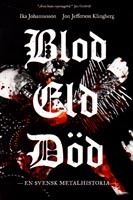When I first saw the cover to Blod Eld Död, the name stuck in my head immediately. I recognized it from somewhere, but couldn't place it. Maybe it was a translation, so I translated it to English and ended up with Blood Fire Death. Of course - it was the title of Bathory's album from 1988[a]. I scanned the table of contents and found, to my great satisfaction, that a whole chapter about Bathory started on page 49.

Blod Eld Död
Ika Johannesson and Jon Jefferson Klingberg
ISBN: 9789150113341
Alfabeta, 2011
Swedish
- Editions
- Blood Fire Death - The Swedish Metal Story
English edition from Feral House
ISBN: 9781627310673
- Blood Fire Death - The Swedish Metal Story
A good read for just about everyone, and a must-read for anyone who has been in contact with the Swedish death- and black metal scene. (5/5)
I came in contact with Bathory and metal in junior high school. I never got into it any more than listening to the music - no leather jacket, no skin-tight jeans; but ever since hearing Wherever I May Roam[b] by Metallica, metal has been part of the music I listen to. I remember being introduced to Bathory[c] by a friend of a friend, and to put it simply, it was unlike anything I've ever heard. Bathory was a one man band, consisting of Ace Forsberg, or Quorthon[d] as his nom-de-metal was, an incredibly gifted guy from Vällingby in western Stockholm.
For those who look up Bathory and are shocked at the goat heads, pentagrams, inverted crosses and all, I'll quote Quorthon on the matter: You have to draw a very thick line between what you do on stage and privately
[1]. The inability of the second wave of black metal bands to do this was what caused me to leave the genre; I dont mind going to fantasy land, but I want a return ticket. Quorthon himself ended up disturbed by his own image, complaining that People have this image of me as some kind of blood-sucking vampire living in a cave in Sweden. I don't put six months into playing the guitar and trying to write good lyrics in order to have to answer questions like "When did you last kill a child?"
[2] Sadly, Quorthon died of a heart attack in 2004.
Since my involvement with the black and death metal scene was so superficial, the book's many chapters about the core of the scene make for interesting reads. As most people involved seem to have some kind of mental disorder I can't say I missed out on anything worthwhile, but it is sure interesting to read about it. Ika and Jon approach the task in a very professional way. Metal, metal iconography, and what can loosely be termed the "metal lifestyle", is full of extremes; yet Ika and Jon manage to describe it without getting lost in either shock-shlock nor simply writing everyone off as lost little boys. Perhaps it is their own love of metal that enables them to balance on such a very fine edge.
They can even take a step back and view the metal scene from the outside, pointing out the absurdities in it, without appearing to ridicule it. For example, in regards to the race to be the most "true" and "evil" black metal band, an interviewee summarizes the silliness it leads to What the hell are you saying - the food tastes good? It tastes evil!
[3]. The result is a very well-balanced view of the metal sub-culture; neither the moral panic of the shocked outsider, nor the unthinking adulation of the recent convert to whom everything is new, fresh and fantastic.
Thankfully the authors also avoid the death-pit of nerdery, where factoid upon factoid are stacked on top of each other, losing the forest in a mass of trees. It isn't an exhaustive history, so don't expect to find your favorite obscure metal band here, but what it lacks in individual facts it makes up for in the multitude of perspectives and the depth of analysis it offers.
The book consists of fifteen self-contained chapters, and while the subtitle is "A Swedish History of Metal", the book doesn't present a chronological perspective, instead opting for fifteen perspectives of the Swedish metal scene. The advantage with this structure is that the authors can choose the best way to approach each topic, and can focus on a single aspect, instead of being locked into a timeline; a great boon when, for example, diving into the gender gap of metal in the tenth chapter, By Men, For Men
[4].
In summary, the book is a good read for just about everyone, and a must-read for anyone who has been in contact with the Swedish death- and black metal scene.
That one, for example, is something of the most beautiful I've seen all my life. It's so darn beautiful. Damn, in my eyes it's the most beautiful image one can see, sort of. Yes, it looks so damn metal that it's just spewing from it, damn it.
Footnotes
[1] | p. 171, from Hetal Hammer, 1987 |
[2] | p.64, Kerrang!, 1990. Translated to Swedish as: |
[3] | p. 150 |
[4] | p. 225 |